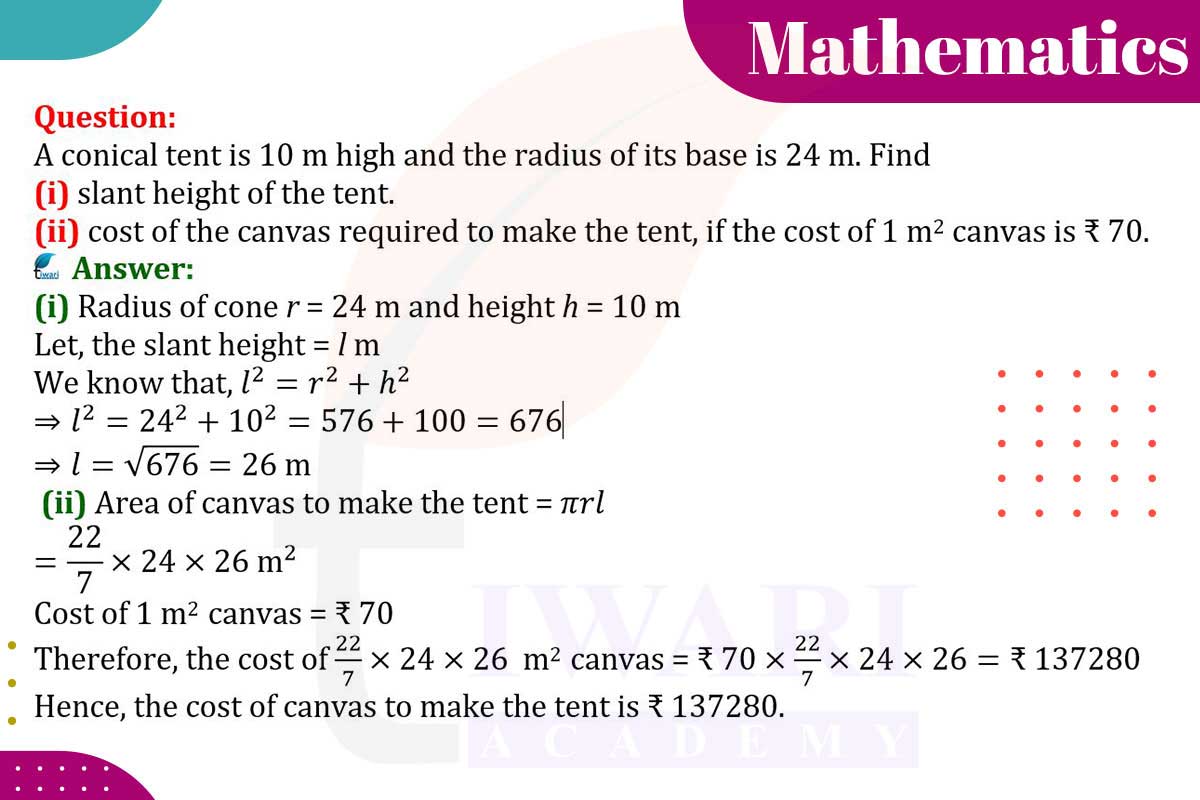(i) The slant height (l) of the conical tent can be found using Pythagoras’ theorem: √[h² + r²], where h = 10 m and r = 24 m. So, l = √[10² + 24²] = √[100 + 576] = √[676] = 26 m.
(ii) The curved surface area (πrl) is 3.14 × 24 × 26 ≈ 1961.76 m². The cost is 1961.76 × ₹70 ≈ ₹137,323.20.

Let’s discuss in detail
Introduction to Conical Tent Geometry
Conical tents are a classic example of practical applications of cone geometry. They consist of a circular base and a pointed top, resembling the geometric shape of a cone. Understanding the dimensions and surface area of a conical tent is crucial for various purposes, including manufacturing and cost estimation. In this scenario, we are given a conical tent with a height of 10 meters and a base radius of 24 meters. Our task is to determine the slant height and the cost of the canvas required to construct the tent.
Determining the Slant Height
The slant height of a conical tent is a key dimension that connects the vertex of the tent to any point on its base’s circumference. It is not the same as the height of the tent, which is the perpendicular distance from the base to the vertex. To calculate the slant height, we use Pythagoras’ theorem, which states that in a right-angled triangle, the square of the hypotenuse (slant height, in this case) is equal to the sum of the squares of the other two sides (height and radius of the tent).
Applying Pythagoras’ Theorem
In our case, the height (h) of the tent is 10 meters, and the radius (r) of its base is 24 meters. According to Pythagoras’ theorem, the slant height (l) can be calculated using the formula l = √[h² + r²]. Substituting the given values, we get l = √[10² + 24²] = √[100 + 576] = √[676] = 26 meters. This is the length of the canvas from the base to the vertex along the tent’s surface.
Calculating the Curved Surface Area
The next step is to calculate the curved surface area of the tent, which is essential for determining the amount of canvas needed. The curved surface area of a cone is given by the formula πrl. With the radius of 24 meters and the slant height of 26 meters, the curved surface area is 3.14 × 24 × 26 ≈ 1961.76 square meters. This area represents the total canvas required to cover the tent’s surface.
Calculating the Cost of Canvas
To estimate the cost of the canvas, we need to multiply the total area of the canvas by the cost per square meter. Given that the cost of 1 square meter of canvas is ₹70, the total cost for the canvas required for the tent is calculated by multiplying the curved surface area by this unit cost. Therefore, the total cost is 1961.76 × ₹70 ≈ ₹137,323.20.
Conclusion and Practical Implications
This calculation of the slant height and the cost estimation for the canvas required for a conical tent is not only a practical application of geometric principles but also crucial in real-world scenarios like tent manufacturing and event planning. Accurate calculations ensure efficient use of materials and budgeting, highlighting the importance of geometry in everyday applications. The ability to translate geometric formulas into tangible outcomes like this is a valuable skill in various industries.
Discuss this question in detail or visit to Class 9 Maths Chapter 11 for all questions.
Questions of 9th Maths Exercise 11.1 in Detail


